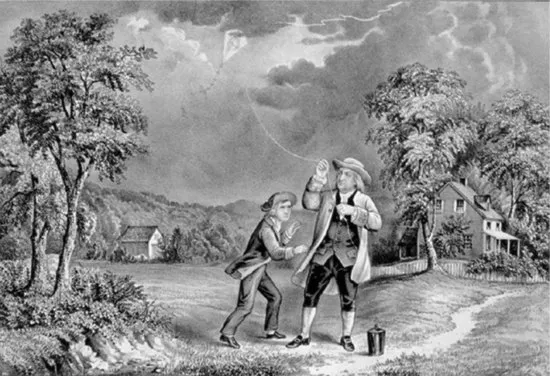![]()
CHAPTER 1
ELECTRICITY—BASIC CONCEPTS
“I am an expert of electricity. My father occupied the chair of applied electricity at the state prison.”
—W. C. Fields (first half of the twentieth century)
“It is the triumph of civilization that at last communities have obtained such a mastery over natural laws that they drive and control them. The winds, the water, electricity, all aliens that in their wild form were dangerous, are now controlled by human will, and are made useful servants.”
—Henry Ward Beecher (mid-nineteenth century)
“We’ve arranged a civilization in which most crucial elements profoundly depend on science and technology.”
—Dr. Carl Sagan (second half of the twentieth century)
1.1 INTRODUCTION
Electrical power and its applications so completely pervade our lives that it is hard to imagine that a little over 100 years ago electricity in homes and businesses was a novelty about which architects did not have to concern themselves. As Carl Sagan’s quote implies, today we are fully dependent on electrical power. It is not surprising that the architecture of a building can be significantly affected by the need to supply power to lights and appliances. Although the architect rarely designs the electrical system, space must be allocated to transformer vaults and electrical closets. When supplying power to an open-plan office, the architect must understand the options in power and communication distribution systems since they can have major aesthetic consequences. For example, using power poles in an open plan office may be efficient but not desirable from an aesthetic point of view.
Specifying appliances and lighting fixtures sometimes requires an understanding of electricity. For example, some lighting fixtures are available in both 277V and 120V versions, and some appliances are available in both 120V and 240V. On what basis does one choose? Some appliances have a poor power factor. What does that mean, and what are the consequences? Should the building use one-phase or three-phase power? What is the difference?
Since many fires are caused by electrical failures, understanding electricity is also important for the safety of buildings and their occupants. Electrocution, although rare, can be practically avoided by proper design and specifications. Understanding electricity provides the reader with personal safety as well. For example, electrical shock can usually be prevented by the use of a ground fault circuit interrupter. How does such a device function, and how should it be used?
And most important of all, buildings must become much more sustainable. Since buildings consume over 70 percent of all electricity in the United States, reducing the consumption of electricity by buildings is of the utmost importance.
Thus, for many reasons, it is important to have an understanding of the basic concepts of electricity.
1.2. HISTORY OF ELECTRICITY
Static electricity was known to and described by the ancient Greeks around 600 BCE. Electricity was rediscovered during the Scientific Revolution of the sixteenth and seventeenth centuries. Investigation into electricity began in earnest in the seventeenth century, and by the middle of the eighteenth century, with the increased knowledge of its properties, Benjamin Franklin concluded that lightning must be made of electricity, which he proved with his famous kite and key experiment in 1752 (Fig. 1.2a). It was not only luck that prevented him from being electrocuted as were some other experimenters. He knew enough about electricity to take certain precautions, such as standing in a dry, sheltered location while flying his kite in a thunderstorm. He also knew that some materials were conductors (his wet kite string) and insulators (a dry silk ribbon by which he held the key). His understanding of electricity allowed him to invent the lightning rod for the purpose of protecting buildings.
The science of electricity developed rapidly after Alessandro Volta invented the battery in 1792, and thereby made available a steady flow (current) of electricity. Thereafter, the discovery of the relationship between magnetism and electricity made the development of electric motors, generators, and transformers possible. Besides Volta, some of the other scientists whose names have been immortalized by their adoption for use as names for electrical units are: Andre Ampere, George Ohm, and Heinrich Hertz. Although much was known about electricity, its composition remained a mystery until the end of the nineteenth century, when it was discovered that electricity is a stream (current) of electrons flowing from negative to positive charges.
Thomas Edison put electricity to work. Until Edison perfected the electric lamp in 1879, all light sources came from open flames that created soot, heat, and often fire. Many had experimented with electric lighting, but Edison was the first to make it a practical reality. His creativity, versatility, and perseverance allowed him to succeed where many others had failed. To sell electric lamps, Edison had to also supply electricity, which required the invention of the electrical production and supply system. He opened his first direct-current central generating stations in both New York City (Fig. 1.2b) and London in 1882.
Of course, being an innovator, Edison also made mistakes. One of his biggest was to believe that direct current (dc) was better than alternating current (ac). Nicola Tesla, the great inventor and scientist, tried to convince Edison of the superiority of ac. Because he could not convince Edison, he sold his patent...


